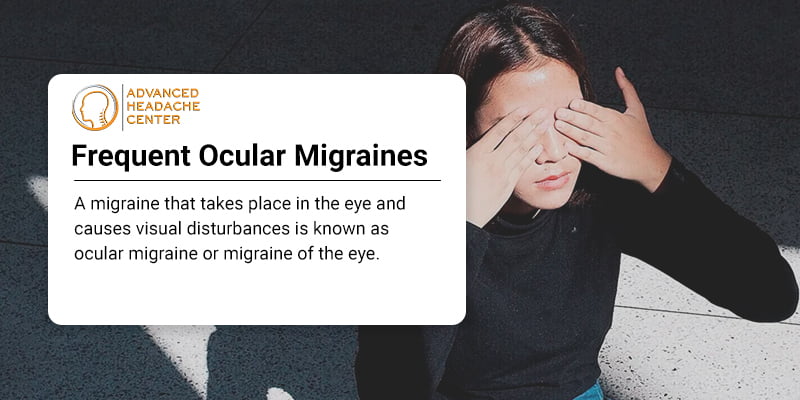Ocular migraines can interfere with your ability to perform routine tasks like reading, writing, or driving as they cause visual disturbances and even temporary vision loss. Seek help from pain doctors experienced in diagnosing and treating every type of headache if your symptoms are occurring too frequently and the episodes last longer than the previous ones. Pain management experts at Advanced Headache Center can diagnose the true causes of your pain and recommend the best line of treatment to provide relief.
What Is an Ocular Migraine?
A migraine that takes place in the eye and causes visual disturbances is known as ocular migraine or migraine of the eye. Also known as optical migraine, an ocular migraine can manifest as a variety of different visual disturbances. They can be frightening, but in most cases, they are harmless and short-lived, and the eyesight goes back to normal afterward.
It is a common occurrence, especially for those who experience an aura before the migraine. This condition is characterized by temporary vision loss or even temporary blindness in one eye.
Some of the most commonly experienced symptoms of ocular migraine include:
- Zigzag lines
- Bright flashes of light
- Shadows in the vision
- Scotomas or blind spots (loss of vision in a certain area of the visual field, typically in the peripheral vision)
- Scintillations or sparkling, usually of lights or stars but can also be blind spots
For some people, ocular migraines can be painless. They can also occur with or follow a migraine headache. An ocular migraine is different from an aura as it typically occurs in one eye and lasts only a few minutes to an hour. Ocular migraines can affect your ability to perform tasks like reading, writing, or driving. Luckily, the symptoms are temporary, and an ocular migraine is not considered a dangerous condition.

What Causes Ocular Migraines?
Migraines are caused by cortical spreading depression. It is a medical term used for describing abnormal activity in the brain that usually starts in the occipital lobe or the back of the head and slowly but steadily spreads through the rest of the brain. Medical researchers believe that ocular migraine has the same causes as classic migraine, and it can result from the same phenomenon that occurs in the retina of the eye.
The exact causes of ocular migraines are not known. A family history of migraines and genetic links are identified as risk factors. It is necessary to see a pain doctor to get the optical migraine properly diagnosed, to know what is causing it and if it is an indication of some underlying condition.
Causes of frequent ocular migraines include:
- Certain lights, sounds, or smells
- Staring at a computer screen or reading for long periods
- Certain foods like nitrates or MSG
- Changes in weather or barometric pressure
- Hormonal changes
- Dehydration
- Stress or anxiety
Keeping a track of ocular migraines and observing what triggers them can determine what is causing them. However, a sudden increase in the frequency of ocular migraines is cause for concern, and you must consult a headache specialist to know more about it and get it properly diagnosed. Also, if you are suffering from this kind of pain and symptoms for the first time, seek medical help.
Ocular Migraines Treatment and Medication
Optical migraines are challenging to treat as they occur for a very short time and usually go away within an hour. It is necessary to consult a doctor who will recommend the medications according to the frequency of the migraines as the treatment usually focuses on preventing and reducing the symptoms.
Your doctor might suggest mediations that include:
- NSAIDs (non-steroidal anti-inflammatories) like ibuprofen for occasional ocular migraine
- Tricyclic antidepressants such as amitriptyline
- Calcium channel blockers such as amlodipine
In certain cases, the medication used for treating epilepsy has also proved helpful with an ocular migraine.
If you are performing tasks that require a clear vision when an ocular migraine occurs, stop what you are doing and relax until it passes. Even if you are driving, pull off the road and wait for your vision to return to normal before moving forward.
Curing Optical Migraine
There is no cure for optical migraines, but medications, lifestyle adjustments, and other therapies can ease the symptoms and reduce the frequency of migraines. Consulting an expert pain doctor is essential as you become sensitive to symptoms with every migraine episode, and it can lead to chronic headaches and migraines.
When to See a Doctor?
You must seek medical help immediately if your ocular migraines are accompanied by other symptoms that include:
- Severe, frequent, or disabling headaches
- Sensory problems
- Nausea and vomiting
- Visual symptoms that affect only one eye
- Frequent episodes of headaches
- Convulsions with a headache
- Loss of alertness or confusion with a headache
- Headaches that require pain medications more than twice weekly
Even if the optical migraines exist alone and do not result from an underlying condition, the pain can be overwhelming and affect your life to a great extent. You should rest and avoid triggers such as bright light until the visual disturbances have passed before doing anything.
Do not let ocular migraines affect your work and quality of life. Consult top-rated pain expert doctors experienced in diagnosing and treating every type of migraine to present the best solutions for alleviating your pain. Schedule an appointment with the experienced physicians at Advanced Headache Center to discuss your symptoms and get a unique perspective on the available treatment and prevention options.




